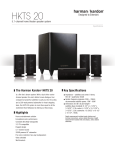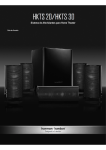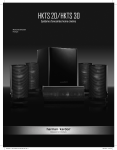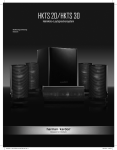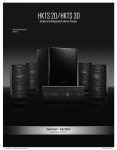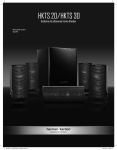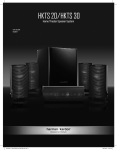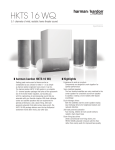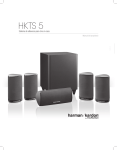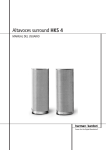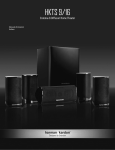Download Harman Kardon HKTS 30 Satellite Owner's Manual
Transcript
HKTS 30SAT-2 Speaker pair User Guide English................................ Deutsch.............................. Suomi................................ Français.............................. Italiano................................ Español............................... Svenska.............................. ............................. Nederlands.......................... Harman Kardon HKTS 30SAT-2 ® Introduction Included Thank you for purchasing the Harman Kardon® HKTS 30SAT-2 speaker pair, with which you’re about to begin many years of listening enjoyment. While state-of-the-art speaker components are hard at work within the HKTS 30SAT-2, hookup is simple. Color-coded cables make the HKTS 30SAT-2 easy to use. Two HKTS 30SAT-2 satellite speakers To obtain maximum enjoyment from your new speaker system, we urge you to take a few minutes to read through this manual. It will help ensure that the connections you make to your receiver or amplifier are correct. If you have any questions about this product, its installation or its operation, please contact your dealer, the best local source of information. Two wall-mount brackets Description and Features The HKTS 30SAT-2 is a pair of speakers, each of which features: • Dual 3" (75mm) video-shielded midrange drivers • One 3/4" (19mm) video-shielded dome tweeter • A sealed enclosure • A built-in, removable base • A wall-mount bracket • Color-coded connecting cables The speaker cables use a color-coding system to conform to the Consumer Electronics Association (CEA®) standard. This color-coding system minimizes confusion when you connect the speakers, especially when you are connecting them to a Harman Kardon receiver. Optional HTFS 3/E floor stands are available separately from your Harman Kardon dealer. Two metal stop plates and screws Two 10-meter (32.8-foot) speaker cables (brown and tan color bands) 2 Speaker Placement Mounting Options for HKTS 30SAT-2 Speakers Expanding a 5.1-Channel System to a 7.1-Channel System Shelf Placement The surround back speakers should be placed against the rear wall directly behind the listeners, 3–6 feet (0.9m–1.8m) apart, 5–6 feet (1.5m–1.8m) off the floor. Surround Back Right Speaker You can place the HKTS 30SAT-2 speakers on shelves. The satellite speakers have built-in bases for shelf placement. You can also remove the bases if you desire. To remove a speaker’s base, pull it straight off the speaker, as shown in the illustration. Applying even pressure to both sides of the base will allow it to slide off smoothly. Surround Back Left Speaker 3 – 6 ft (0.9m – 1.8m) Wall-Mounting IMPORTANT: Read the Speaker Connections section, on page 5, before wall-mounting the HKTS 30SAT-2 speakers. You will need to insert the speaker wires through the wallmount brackets and connect the wires to the speakers during the process of installing the wall-mount brackets. 5 – 6 ft (1.5m – 1.8m) Front Left Speaker TV Center Speaker Surround Left Speaker Lift base straight off speaker Apply pressure evenly to both sides of base Front Right Speaker Pull sections apart NOTE: If you are using your own speaker wire, it must be no thicker than the wire supplied with the speakers. Thicker wire will prevent the wall-mount bracket from sliding onto the speaker. 1. Decide on the location for the speaker (see Speaker Placement, opposite). Subwoofer 2. Remove the speaker’s base as explained in Shelf Placement, above. Surround Right Speaker 3. Disassemble the wall-mount bracket by sliding the two sections apart, as shown in the illustration. If original surround speakers are behind listeners, move them to a point to directly at listeners' sides Surround Back Left Speaker 4. Attach the wall portion of the wall-mount bracket onto the wall using hardware that is appropriate for the wall’s construction and materials. We recommend first anchoring the wall-mount bracket using its keyhole, then attaching it with another anchor through its top opening, as shown in the illustration. Note that the HKTS 30SAT-2 speakers weigh 3.3 lb (1.5kg). Be sure to use hardware that can support this weight. Surround Back Right Speaker NOTE: If your original surround speakers are located behind the listeners, you should move them up so they are directly to the listeners’ sides. If You’re Adding to an Existing HKTS 30 Speaker System: Top opening Your HKTS 30SAT-2 speakers are designed to expand an existing HKTS 30 speaker system from 5.1 channels to 7.1 channels. You can connect the HKTS 30SAT-2 speakers to your receiver’s or amplifier’s surround back left and surround back right outputs. Keyhole opening Bottom opening If You’re Adding to an Existing HKTS 20 Speaker System: Your HKTS 30SAT-2 speakers are designed to expand an existing HKTS20 speaker system from 5.1 channels to 7.1 channels by replacing the existing front left and front right speakers. You can then connect your existing HKTS20 front left and front right speakers to your receiver’s or amplifier’s surround back left and surround back right outputs. 3 8. Connect the speaker wire to the speaker terminals, as shown in the illustration: • Press down on the top of the terminal to open the connection hole. • Insert the wire’s bare end all the way into the hole. • Release the terminal to secure the wire. NOTE: If you’re running the speaker wire through the wall, you can bring it out directly behind the wall-mount bracket’s location and insert it through the bottom opening in the wall portion of the wall-mount bracket, as shown in the illustration. Inserting it will keep the wire completely hidden from view once the installation is complete. Insert the conductor with the colored band into the speaker’s red ( + ) terminal, and insert the other conductor into the speaker’s black ( – ) terminal. Insert wire into bottom opening Bring wire out through here – + 5. If you’re not running the speaker wire through the wall, insert it through the wall portion of the wall-mount bracket, as shown in the illustration. Push down on cap to open hole Insert bare wire into open hole Release cap to secure wire IMPORTANT: Make sure the ( + ) and ( – ) bare wires do not touch each other or the other terminal. Touching wires can cause a short circuit that can damage your receiver or amplifier. 9. Slide the speaker portion of the wall-mount bracket onto the speaker, as shown in the illustration. Fit the wall-mount bracket’s grooves onto the rails in the speaker, and apply even pressure on both sides of the wallmount bracket so it slides straight onto the speaker. • Push the wall-mount bracket all the way onto the speaker until it snaps into place. • Pull any slack speaker wire back through the wall-mount bracket as you slide the wall-mount bracket onto the speaker. Push down evenly on both sides of wall-mount bracket 6. Pass the speaker wire through the speaker portion of the wall-mount bracket, as shown in the illustration. Fit bracket grooves onto speaker rails Bring wire in through here Bring wire out through here 10. Slide the speaker onto the wall-mount bracket’s wall section, as shown in the illustration. Pull any slack speaker wire back through the wall-mount bracket's wall section. Slide speaker onto wall-mount bracket 7. If you have not already removed the speaker’s base, do so by pulling it straight off the speaker, as shown in the illustration. Applying even pressure to both sides of the base will allow it to slide off smoothly. Apply pressure evenly to both sides of base Lift base straight off speaker 11. Fit the metal stop plate into the recess on the bottom of the wall-mount bracket with the pad facing the bracket, and fasten it to the bracket using two of the supplied screws. Fastening it will prevent the speaker from detaching from the wall-mount bracket and will hold the speaker in position as you rotate it on the wall-mount bracket. CAUTION: Before making speaker connections, be sure that your receiver or amplifier is turned OFF and, preferably, its AC cord is unplugged from the AC outlet. Stop plate Supplied screws 4 Speaker Connections CAUTION: Before making speaker connections, be sure that your receiver or amplifier is turned OFF and, preferably, its AC cord is unplugged from the AC power outlet. Connecting HKTS 30SAT-2 Speakers with the Supplied Wall-Mount Brackets Color-Coding System Follow the instructions in Wall-Mounting on page 3. The HKTS30 SAT-2 uses the channel color-coding system established by the Consumer Electronics Association (CEA) to make setting up your home theater speaker system as easy as possible. The HKTS 30 systems include speaker wires with colored bands on each end. Connecting HKTS 30SAT-2 Speakers with the Supplied Bases Speaker Position Wire Color Band Surround Back Left Brown Surround Back Right Tan 1. Remove the speaker’s base (see Shelf Placement, on page 3). 2. Pass the speaker wire through the opening in the speaker’s base. 3. Connect the speaker wire as described in Color-Coding System, opposite. 4. Reattach the speaker’s base, as shown in the illustration. Speakers and receivers/amplifiers have corresponding ( + ) and ( – ) connection terminals. Most electronics manufacturers, including Harman Kardon, have been using red to denote the ( + ) terminal and black for the ( – ) terminal. Newer Harman Kardon receivers conform to the CEA standard and therefore use a color other than red to denote the ( + ) terminal for some speaker positions. Each speaker wire included with your system has colored bands at both ends of the ( + ) conductor. In addition to the colored bands at each end, each speaker wire’s ( + ) terminal has ribs molded into its insulation to help you identify it, while the (–) terminal has no ribs. It is very important to connect each speaker identically: ( + ) on the speaker to ( + ) on the receiver or amplifier, and ( – ) on the speaker to ( – ) on the receiver or amplifier. Miswiring one or more speakers results in thin sound, weak bass and a poor stereo image. With the advent of multichannel surround-sound systems, connecting all of the speakers in your system correctly is very important for achieving the proper ambience and directionality of the sound coming from the speakers. To connect the speaker wire to the terminals on the speakers, press down on the top of the terminal to open the connection hole, insert the wire’s bare end all the way into the hole, and release the terminal to secure the wire. Insert the conductor with the colored band into the speaker’s red ( + ) terminal, and insert the other conductor into the speaker’s black ( – ) terminal, as shown in the illustration. + Push down on cap to open hole Insert bare wire into open hole – Release cap to secure wire IMPORTANT: Make sure the ( + ) and ( – ) bare wires do not touch each other or the other terminal. Touching wires can cause a short circuit that can damage your receiver or amplifier. 5 Receiver Surround Back + – RIGHT LEFT + – Surround Back Left Speaker Cable (Brown Bands) – Surround Back Right Speaker Cable (Tan Bands) – + Surround Back Left Surround Back Right 6 + Troubleshooting If there is no sound from any of the speakers: • Check that the receiver/amplifier is on and a disc or other source is playing. • Make sure that all wires and connections between the receiver/amplifier and the speakers are connected properly. • Make sure that none of the speaker wires is frayed, cut or punctured. • Review the proper operation of your receiver/amplifier. If there is no sound coming from one speaker: • Check that the balance control on your receiver/amplifier is not set all the way to one channel. • Check your receiver/amplifier’s speaker setup procedure to make sure that the speaker in question has been enabled and its volume level has not been turned all the way down. • Make sure that all wires and connections between the receiver/amplifier and the speaker are connected properly. • Make sure that none of the speaker wires is frayed, cut or punctured. If there is no sound coming from the surround speakers: • Check your receiver/amplifier’s speaker setup procedure to make sure that the surround speakers have been enabled and their volume levels have not been turned all the way down. • Make sure that all wires and connections between the receiver/amplifier and the surround speakers are connected properly. • Make sure that none of the speaker wires is frayed, cut or punctured. • Review proper operation of your receiver/amplifier and its surroundsound features. • Make sure that the movie or TV show you’re watching has been recorded in a surround-sound mode. If it has not, check to see if your receiver/amplifier has a different surround-sound mode that you can use. • Review the operation of your DVD player and the DVD jacket to make sure the DVD features the Dolby ® Digital or DTS ® surround-sound mode and that you have selected that mode using both the DVD player’s menu and the disc’s menu. If the system plays at low volumes but shuts off as volume is increased: • Make sure that all wires and connections between the receiver/amplifier and the speakers are connected properly. • Make sure that none of the speaker wires is frayed, cut or punctured. • If you’re using more than one pair of main speakers, check to be sure that you’re not operating the system below the receiver/amplifier’s minimum impedance requirements. If you're not sure sure how to check the impedance, ask your audio retailer. 7 Specifications HKTS 30SAT-2 Satellites Recommended Power 10 ~ 120 watts Impedance 8 ohms nominal Sensitivity 86dB @ 2.83V/1 meter Tweeter One 3/4" (19mm) dome, video-shielded Midrange Dual 3" (75mm) drivers, video-shielded Dimensions – including stands (H x W x D) 11-25/32" x 4-11/32" x 3-15/32" (299mm x 110mm x 88mm) Weight 3.3 lb (1.5kg) © 2010 Harman International Industries, Incorporated. All rights reserved. Features, specifications and appearance are subject to change without notice. Harman Kardon is a trademark of Harman International Industries, Incorporated, registered in the United States and/or other countries. Designed to Entertain is a trademark of Harman International Industries, Incorporated. CEA is a registered trademark of the Consumer Electronics Association. Dolby is a registered trademark of Dolby Laboratories. DTS is a registered trademark of DTS, Inc. Harman Consumer, Inc. 8500 Balboa Boulevard, Northridge, CA 91329 USA 516.255.4545 (USA only) www.harmankardon.com Made in P.R.C. Part # 950-0289-001 8










